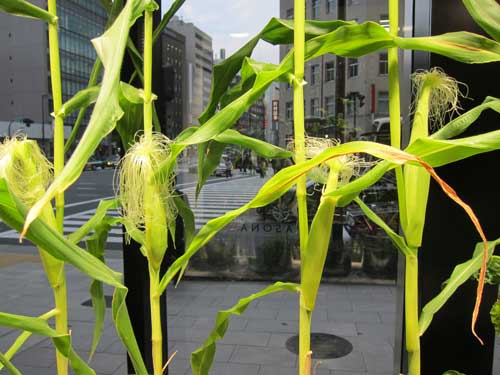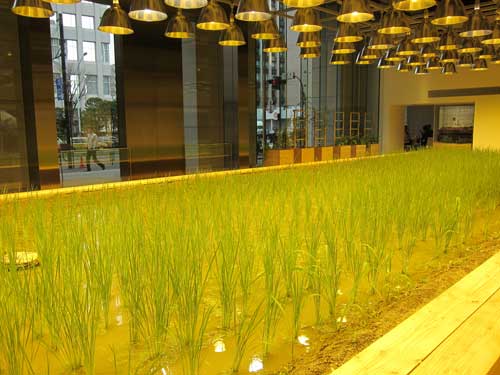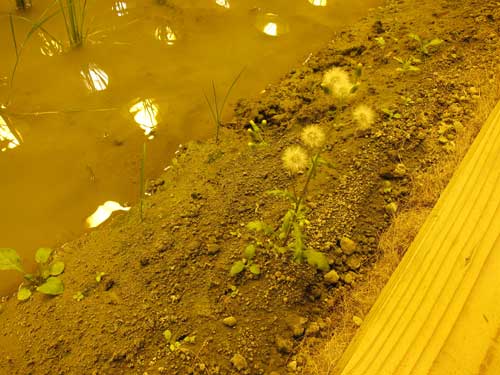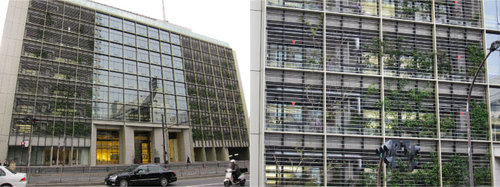What roles can corporations play in transforming urban landscapes? This year Pasona, one of Japan's top temporary staffing agencies, constructed a bold new headquarters building in Tokyo's central business district that brings nature into the work environment and out to the street.

Pasona's flashy interior farm and its elaborate yet less visible vertical garden activate normally dead spaces. While the results are uneven, the efforts to remake urban space and to use urban landscape to tell a new story about its corporate owner are remarkable.
Almost the entire ground floor of the building is devoted to the spectacle of vegetables planting, growing, and ripening under powerful grow lights: rice, tomatoes, melons, corn, eggplants, herbs, and lettuce. Just inside the main entrance, a rice paddy glows with bright lights and is visible from across the wide downtown street. Beautiful apple trees in giant, rusted steel planters flank the entrance doors.

Other interior features include a cafe with tall corn rising from canvas bags and a wall of leaf vegetables growing in metal cases with purple lights and tiny fans that have a very "next century" feel. A room with racks and racks of lettuce borders a small plot of giant sunflowers. Attractive vignettes of vegetables and seedlings are arranged throughout, and tomatoes hang down from cut-outs in the ceiling.
The lobby area succeeds in demonstrating Pasona's commitment to Japanese agriculture in an era of radical rural depopulation. The mix of cutting edge technology and design also communicates that Pasona is optimistic and outward thinking. These brand stories told through landscape exceed what is expected from a staffing company. Perhaps Pasona seeks to mitigate the social dislocation caused by Japan's recent shift from a majority full-time workforce to a majority of contract laborers.
Nonetheless, the interior space falls short for a number of reasons. The giant rice paddy lobby is stunning but also devoid of people. The strange color, strong heat, and loud sound of the lights seem to repel people. In fact, the employees use a side entrance and bypass the main lobby.
The intensity of the lighting and sheer quantity beg the question of energy expenditure and sustainability. With growth, flowering and food production controlled by lights, there is no sense of season or natural habitat. Why is the corn ripening in May?
Pasona has gotten the most attention for its bold indoor farm, but the exterior vertical garden is ultimately more interesting for urban habitat creation and the integration of nature and work space. Two thirds of the building front and one side wall have been carefully planted on handsome screened balconies to produce four seasons of color. Traditional Japanese garden plants are mixed with exotics, with trees, vines and bushes including citrus, wisteria, Japanese maple, blueberries, and clematis providing color and city food. Although the plants are small now, it is easy to imagine the exterior becoming a unique and colorful vertical garden over the next years that will benefit workers, clients, neighbors, and wildlife.
This exterior landscape has 200 species of plants, including many trees that lose their leaves in the winter. The idea is that summer shade will keep the building cooler, and winter bare branches will allow more direct light during the cold season. While the public is not invited to the upper floors, creating a vertical garden allows workers close access and views of an intricate seasonal garden.
I look forward to watching the exterior of the building grow into its potential. If successful, it can influence the standards that corporations define for well-designed office space, and can inspire governments, property developers, and small residences to maximize green space in cities. Even buildings built to the property line can accommodate elegant gardens.
Pasona's successes and shortcomings may also inspire others to experiment with urban agriculture, wildlife habitat creation, and the creation of new public spaces that add value to corporate brands and dense cities.
Some other notable examples of city center office buildings with innovative landscapes include San Francisco's Pacific Gas and Electric Building that has a high-rise falcon nest monitored by a university research team and web-casted to the public. Also exemplary is Tase Michio's satoyama landscape on the ACROS Fukuoka office building, where visiting birds have contributed dozens of additional plant species; natural growth over the past fifteen years has made this tiered structure a unique urban forest.
While most office space is bland and interchangeable, corporations have tremendous resources for creating new types of spaces that benefit employees, customers, vendors, and neighbors. New landscapes can bring life to workspaces, retail stores, delivery systems, outdoor advertising, and sponsored events and parks.
I'll end this article with an image of a dandelion weed I spotted on the edge of Pasona's rice field. It is this type of unplanned feature that makes natural landscapes so enchanting. How can urban landscape be designed to best promote nature's active resilience?

Jared Braiterman PhD writes a blog about Tokyo Green Space, and his research has been published in Japan, China, Europe, Latin America, and the United States.

